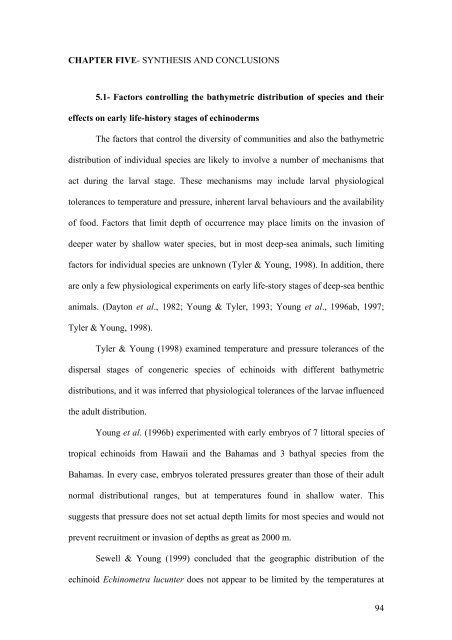Download (3398Kb) - ePrints Soton - University of Southampton
Download (3398Kb) - ePrints Soton - University of Southampton
Download (3398Kb) - ePrints Soton - University of Southampton
You also want an ePaper? Increase the reach of your titles
YUMPU automatically turns print PDFs into web optimized ePapers that Google loves.
CHAPTER FIVE- SYNTHESIS AND CONCLUSIONS<br />
5.1- Factors controlling the bathymetric distribution <strong>of</strong> species and their<br />
effects on early life-history stages <strong>of</strong> echinoderms<br />
The factors that control the diversity <strong>of</strong> communities and also the bathymetric<br />
distribution <strong>of</strong> individual species are likely to involve a number <strong>of</strong> mechanisms that<br />
act during the larval stage. These mechanisms may include larval physiological<br />
tolerances to temperature and pressure, inherent larval behaviours and the availability<br />
<strong>of</strong> food. Factors that limit depth <strong>of</strong> occurrence may place limits on the invasion <strong>of</strong><br />
deeper water by shallow water species, but in most deep-sea animals, such limiting<br />
factors for individual species are unknown (Tyler & Young, 1998). In addition, there<br />
are only a few physiological experiments on early life-story stages <strong>of</strong> deep-sea benthic<br />
animals. (Dayton et al., 1982; Young & Tyler, 1993; Young et al., 1996ab, 1997;<br />
Tyler & Young, 1998).<br />
Tyler & Young (1998) examined temperature and pressure tolerances <strong>of</strong> the<br />
dispersal stages <strong>of</strong> congeneric species <strong>of</strong> echinoids with different bathymetric<br />
distributions, and it was inferred that physiological tolerances <strong>of</strong> the larvae influenced<br />
the adult distribution.<br />
Young et al. (1996b) experimented with early embryos <strong>of</strong> 7 littoral species <strong>of</strong><br />
tropical echinoids from Hawaii and the Bahamas and 3 bathyal species from the<br />
Bahamas. In every case, embryos tolerated pressures greater than those <strong>of</strong> their adult<br />
normal distributional ranges, but at temperatures found in shallow water. This<br />
suggests that pressure does not set actual depth limits for most species and would not<br />
prevent recruitment or invasion <strong>of</strong> depths as great as 2000 m.<br />
Sewell & Young (1999) concluded that the geographic distribution <strong>of</strong> the<br />
echinoid Echinometra lucunter does not appear to be limited by the temperatures at<br />
94
















